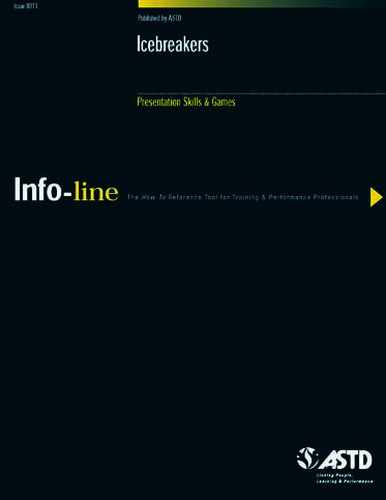Renderas:sect2. Variables
Several considerations come into play once the trainer decides to use an icebreaker. Plan carefully, based on the following variables:
Group composition This information includes age range, cultural background, gender, and education level.
Target audience Salespeople, who are normally extroverted, probably don't require an exercise designed to foster introductions, while other groups may need a nudge to get things started.
Program length Short courses (half-day) may spare only five or 10 minutes for icebreaking; day-long course icebreakers may last 15 to 20 minutes; in courses of four or five days, icebreaking may involve up to two hours.
Program content Topics should echo the content of the course, but they may not be tied to it directly. Openers may summarize what has preceded or act as a transition to the next course segment. Openers also may contribute to participants becoming better acquainted.
Trainer's style This determines what type of icebreaker to use. More experienced trainers—those who don't fear losing control of the participants or sight of the subject—may opt for novel or experimental exercises that allow for more free flow. Less experienced trainers might use more structured exercises.
Although icebreakers are marvelous training tools, they can be misused. To minimize risks and maximize benefits, Forbess-Greene recommends the following:
Trainers should encourage the active participation of all group members.
Data or information generated during an exercise may be deeply personal and intended only for the group. Trainers should warn participants to keep such information “in the room.”
The trainer's active participation may help reduce the participant's initial inhibitions and promote risk taking.
Barriers to Successful Use of Icebreakers
Here are a few obstacles to the effectiveness of icebreakers and some suggestions for overcoming them:
Barriers Solutions Lack of clarity in the trainer's explanation of the process or exercise content, or both. Be very clear and specific about instructions and expectations. Previously existing relationships among participants. Take an active role in encouraging everyone to talk with as many other participants as possible. Differences in job type or status among group members. Establish behavioral guidelines that require some heterogeneous interaction. Devaluing of a person's contribution by someone (trainer or another participant) during the process. Emphasize the importance of positive behavior and a nonjudgmental attitude during the icebreaker. Charisma of one or more participants that causes trainees to focus their attention solely on them. Stress that the icebreaker is nothing more than an introductory or fun exercise. Participant's individual attitudes, including “I don't want to participate or don't feel like participating, and the trainer won't notice”; and “I'm not a good communicator; I always become too self-conscious and worry about people liking me.” Approach any nonparticipants and “pull” them into the activity. The trainer must carefully evaluate an icebreaker's appropriateness to the audience, subject matter, and climate.
The trainer should remain attuned to the development of participants and of the group. Issues such as disclosure, cohesiveness, trust, team building, risk taking, control, and dependence should be closely monitored.
